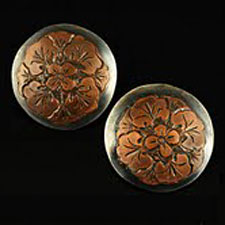2-Roses Studio: A Lifelong Journey of Exploration and Experimentation
 HiTek Fillagree necklace.
HiTek Fillagree necklace.Photograph courtesy of John and Corliss Rose
Corliss Rose and John Lemieux Rose have been artists all their lives. Both received formal artistic training in the United States and abroad. They met in Chicago at the Art Institute, instantly bonded and have been creating innovative designs at 2-Roses Studio in Southern California for over 42 years.
Although they primarily use exotic found objects, copper and brass play a big role in the work they create at 2-Roses.
"We purchase brass, copper and bronze in sheets, tubes and wire," says John. "We fabricate and occasionally cast it. We recycle brass and industrial parts, using them whole or in part as compositional elements. Usually the majority of a piece is made of copper and brass."
Their Botanical Series Brooches employ two-stage dies, which they make themselves.
"It takes several passes through the hydraulic press to achieve the rough volume and shape which is then refined with chasing and repousse," says John. "The shape is cut out by hand or with a pancake die, pierced and properly aligned. We use a combination of soldering, riveting or other forms of cold joining to construct component parts of the botanicals. Once assembled, the brooch is prepped for applying color on metal finish using successive coats of acrylic paint overlaid with colored pencils, metallic powders, dies and a polymer sealant resulting in a durable finish."
 Western Style Engraved earrings.
Western Style Engraved earrings. Photograph courtesy of John and Corliss Rose
From an old stick, scrap brass tube and recycled rubber shoe sole, John designed a color pusher tool for enameling exploration. They credit artist Barbara Minor for passing on the craft of enameling, and showing them how to make unique patinas by manipulating copper.
"Most of it is kiln fired, but we also play with torch firing, currently trying different layering and textural techniques incorporating a wide range of additives to enamel powders," says John. "Copper is highly suited for this development process as it has known characteristics."
Because of John's inventiveness, 2-Roses Studio features a complete machine shop. He modified a cheap metal working hammer dug out of the trash and constructed many tools that save wear and tear on wrists and hands. Corliss likes to say that John wouldn't spend ten cents on a screw when he can go to the studio and make one for ten dollars. Always resourceful, the Roses even obtained old, open bronze dies buried under a pile of junk on a dirt floor in India.
With their wonderful sense of humor, artistic experimentation and philosophy "trash is a failure of imagination," John and Corliss Rose continue their exploratory journey.
2-Roses have exhibited at the Victoria & Albert, The Hermitage, Laguna Museum of Art and numerous art institutions around the country.
Resources:
Also in this Issue:
- The Mica Lamp Company: Beautiful Lighting Inspired by Turn-of-the-Century Craftsmanship
- Warfare Crafted Into Works of Art
- Seeing the Future: Copper Braille Jewelry
- 2-Roses Studio: A Lifelong Journey of Exploration and Experimentation
- Rare Rembrandt Self-Portrait Rediscovered
